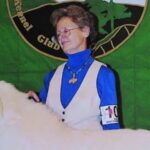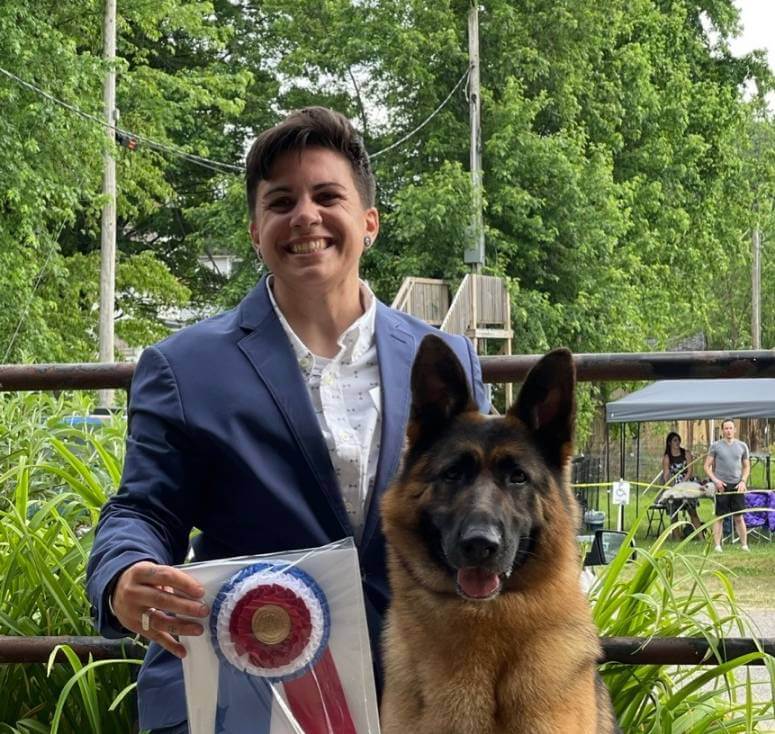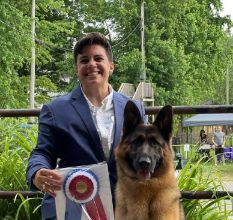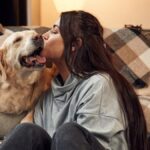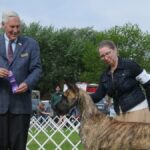Interview with Herding Group Breeder Olivia Calabrese
Where do I live? How many years in dogs? How many years as a breeder?
Olivia Calabrese: I currently live in York, Pennsylvania. I have been in dogs since the day I was born. The first time I was in a show ring handling was when I was five years old. I have been a breeder alongside my mom, Donna, since I was about eight, when I got “the birds and the bees” speech as we were doing a breeding.
What is my kennel name?
Olivia Calabrese: We are Aramist Enterprises and Kennels (German Shepherd Dogs).
Which show dogs from the past have been my noteworthy winners?
Olivia Calabrese: We have been lucky enough to have had many. Growing up, for me, it was our homebred American and Canadian Grand Victrix, ROM. Her name was “Ivana.”
Ivana had the heart of a lion in the ring, and she gave many “the chills” when she gaited around the ring. She did it with suspension, but with such power, and she was “a natural.” We never had to do much training, she just knew… she was a complete package. Ivana was also our housedog. She was not only a great producer, she was one of the all-time Top-Producing Grand Victrix’s in our breed history… she was a great show dog and companion. Ivana was my Junior Handling dog. She taught me a lot. Then, as I aged out and started handling on my own, we had a bitch named “Chyna.” She was also a Canadian Grand Victrix and American Select GCH BIS bitch. I showed her at the all-breeds and helped in ranking her. She was also something else… a great show dog and housedog. Her show career took over and she only had one litter (with some major health difficulties), so we made the decision; no more litters for her.
Which have been our most influential sire and dams?
Olivia Calabrese: Ivana’s mom, we called her “Sweetie Pie,” was a top-producing ROM, also “back in the day.” She combined bloodlines from the famous Amber & Kolbrook top-producing bitch kennels and is what our foundation was based on. Those lines then combined with other top-producing male lines, going back to Covy Tucker Hill, Witmer, Karizma, and Kaleef. This is what made our strong bitch line.
Can I talk a bit about my facilities?
Olivia Calabrese: Yes, I’d be proud to. We have two. We have my mom’s kennel based in Virginia. She and I do the breedings, whelping, and growing up of puppies there, being that she has more time at home with them now that I am a handler and on the road so much. I make time to go down to help her. We discuss upcoming breedings and litters, Aramist’s future, and we also evaluate puppies there and make decisions whether they should go into performance homes, therapy homes or companion homes. We whelp them downstairs in the nursery, so they can be monitored closely. Once they are weaned, they go out to the puppy barn where they have more space and an appropriate setting; they have puppy activity boxes for mental growth, gym equipment for safe physical play, and they get socialized with all possible things to make them sound and healthy.
My own home and facility is here in Pennsylvania, as mentioned, and once we evaluate the puppies and youngsters and know that they will be show dogs, they come to me and we start them with grooming tables and bath tubs, routine scheduling of crate training, and the environment of “on the road” training so that they are well-rounded by the time it is show time… probably much like most… it makes the transition easier when you start young, so there is no stress at the show or in the ring because they are used to it already.
What is my “process” for selecting show puppies and at what age do I make my decisions?
Olivia Calabrese: We start the process very young by just watching them while they are in the whelping box. You see attitude immediately, which is what you need to make a great show dog. Of course, as they start moving around the whelping box, we start evaluating their structure. The harder cuts come at around 5-6 weeks old. When we do a breeding, we are specifically looking to improve on something in this generation. So, if we don’t see it by then, then either we sell as a performance dog, companion dog, or if it’s still of show quality, we sell it to someone looking for something like it. We usually have a waiting list for puppies, so it’s easier to know what they want and what they are looking for when making those selections. We are growing up a litter now. (They were born in October and we still have them.) We tried a different bloodline going back to an imported dog, because our bitch line is very linebred… we wanted to wait and watch them to know their growth stages, since we decided we wanted to keep a male as a stud dog out of this breeding. I think, by now, not only are they proven show prospects, we have done their genetic testing and prelims, and we are very happy with the breeding… and now a couple of girls are ready for their new homes.
How do I prepare my pups for the show ring? Does my breed require any special preparation?
Olivia Calabrese: Yes and no. Our breed is very different than any other breed when it comes to special preparation for the Specialty show ring. The rings are a lot bigger than the all-breed rings. The dogs are shown on more of a loose lead to showcase the German Shepherd’s natural side gait. The German Shepherd standard states, “At a trot the dog covers still more ground with even a longer stride, and moves powerfully but easily, with coordination and balance so that the gait appears to be the steady motion of a well-lubricated machine.” We condition our dogs daily to prepare for the shows by biking and lightly golf carting them to build stamina after they are out of their youngster stage and are “prelimed,” making sure we don’t overdo something that could hurt them physically. We have to teach them not to sidewind, but to go up the long straight-aways smoothly. In an all-breed ring, it is very challenging for a big-moving dog, always making a turn, then teaching them not to sidewind because then they don’t use their forehands. Down and back on a big-moving dog isn’t always easy if they have a lot of transmission, because they need more space to single track. As a movement breed, we run a lot more than most other breeds are accustomed. So, it’s important to keep them (as well as ourselves) as well-conditioned athletes.
Is my breed hand-stacked or free-stacked in the show ring? Why is it presented in this manner?
Olivia Calabrese: Our breed is both hand-stacked and free-stacked based on the judge’s preference. Some judges prefer a presentation that is natural to the dog when standing on its own—a free-stack. There is nothing more fun to show than a dog that will showcase itself.
Are Performance and Companion titles important to me as a breeder? Are parent club titles? Olivia Calabrese: Absolutely, as a breeder, the German Shepherd Dog should be able to do everything. From protection work and herding on a farm to being a therapy dog in someone’s bed—and everything else in between.
In my opinion, is my breed in good condition overall? Any trends that warrant concern?
Olivia Calabrese: There are definitely some beautiful dogs out there right now. Growing up, I’ve seen different styles that range from a little more extreme in the hindquarters to well-balanced, short-coupled animals. For someone my age, I’m very old school. I like a correct, sound, and balanced dog that runs on its feet. Every dog has its good qualities and different faults. Some faults I’m seeing lately would be longer turn of stifle and over-angulation, making uncoordinated movers and immature-looking dogs at four years old.
Is my breed well-suited to be a family dog? Who are the best candidates to own my breed?
Olivia Calabrese: Yes. I do believe this breed is well-suited to be a family dog, but with people who are willing to take direction from the breeders, and willing to give this highly intelligent dog a chance. It is a very smart breed that is great to be around, whether it’s out working or being your housepet laying on your front porch.
Do I feel that my breed is supported by a sufficient number of preservation breeders?
Olivia Calabrese: Our breed is still supported by a decent amount of preservation breeders. Some great legacies have passed as the years go by, but their pedigrees still live on through some of their progeny, and the smart people have learned to research and learn.
For a bit of fun, what’s the most amusing thing I’ve ever experienced with a Herding Dog?
Olivia Calabrese: The most amusing thing I have seen was with my brother’s dog, “Oscar.” He was his housedog and he wanted that dog to do it all. When we were younger, Oscar was introduced to our temperament test, which includes various things like can-shaking, suddenly opening an umbrella, and walking on several different types of surfaces. There is a “friendly stranger” and then there is the “weird stranger” who yells and carries on but keeps a distance. There is also either a gunshot or a whip to make a cracking noise. My brother took Oscar, but he was smart. He watched other tests and simulated them at home (we didn’t know) because you shouldn’t be practicing something that should be natural. So, my brother would open the umbrella that mom had hanging in the house at Oscar all the time to make sure he would pass that part of the test. Well, there was a specialty where they provided the temperament test, and Oscar was doing great up until the next step; the umbrella. The guy running the test had opened the umbrella at Oscar who looked at it, jumped up and grabbed the umbrella, then spit it out and barked; in his words, “That’s all you got?” Needless to say, after grabbing the object, he didn’t pass as he wasn’t allowed to grab it… but it was the funniest thing ever.
Anything else I would like to share about myself? Any special message I have for all of us in the fancy?
Olivia Calabrese: I would like to share that I was raised by two top German Shepherd handlers; my mom, Donna Calabrese, and Leslie Dancosse. I am grateful to keep hitting my goals as a handler and a breeder, and to have the knowledge they provided me—along with other people I grew up with. One very well-known past handler/judge/breeder, Joe Bihari, would make me sit on his couch and watch videos, and critique the dogs with him and show me things. I think I am still learning to this day, which makes me the handler I am. I also work with younger Juniors to help them learn about our breed and our sport, and to try and mentor them along the way. It’s a great way to educate them; by learning all parts of our business and to show that it’s not all about just handling. It teaches them how to take care of animals and what the process is with our work environment, from the time you get up to the time you go to bed. It’s a Dog’s Life, for sure…
A special message to the fancy: As a young handler growing up in this sport, not everyone is “that” lucky to have the option to learn from family members as I did. Remember, each young Junior Handler who is starting out needs us to offer support and advice with a helping hand. We need to inspire them today to be a great “dog person,” not just a great handler; a great breeder, yes, but also to be able to preserve our breed and to, hopefully, become even better than us one day.
